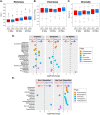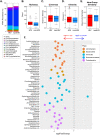Evolution of the Gut Microbiome in HIV-Exposed Uninfected and Unexposed Infants during the First Year of Life
- PMID: 36073815
- PMCID: PMC9600264
- DOI: 10.1128/mbio.01229-22
Evolution of the Gut Microbiome in HIV-Exposed Uninfected and Unexposed Infants during the First Year of Life
Abstract
HIV-exposed uninfected infants (HEU) have abnormal immunologic functions and increased infectious morbidity in the first 6 months of life, which gradually decreases thereafter. The mechanisms underlying HEU immune dysfunctions are unknown. We hypothesized that unique characteristics of the HEU gut microbiota associated with maternal HIV status may underlie the HEU immunologic dysfunctions. We characterized the infant gut, maternal gut, and breast milk microbiomes of mother-infant pairs, including 123 with HEU and 117 with HIV-uninfected infants (HUU), from South Africa. Pan-bacterial 16S rRNA gene sequencing was performed on (i) infant stool at 6, 28, and 62 weeks; (ii) maternal stool at delivery and 62 weeks; and (iii) breast milk at 6 weeks. Infant gut alpha and beta diversities were similar between groups. Microbial composition significantly differed, including 12 genera, 5 families and 1 phylum at 6 weeks; 12 genera and 2 families at 28 weeks; and 2 genera and 2 families at 62 weeks of life. Maternal gut microbiomes significantly differed in beta diversity and microbial composition, and breast milk microbiomes differed in microbial composition only. Infant gut microbiotas extensively overlapped with maternal gut and minimally with breast milk microbiotas. Nevertheless, exclusively breastfed HEU and HUU had less divergent microbiomes than nonexclusively breastfed infants. Feeding pattern and maternal gut microbiome imprint the HEU gut microbiome. Compared to HUU, the HEU gut microbiome prominently differs in early infancy, including increased abundance of taxa previously observed to be present in excess in adults with HIV. The HEU and HUU gut microbiome compositions converge over time, mirroring the kinetics of HEU infectious morbidity risk. IMPORTANCE HIV-exposed uninfected infants (HEU) are highly vulnerable to infections in the first 6 months of life, and this vulnerability decreases to the age of 24 months. Because the microbiome plays a critical role in the education of the infant immune system, which protects them against infections, we characterized the gut microbiomes of HEU and HIV-unexposed infants (HUU) in the first year of life. The HEU and HUU gut microbiomes showed prominent differences at 6 and 28 weeks of life but converged at 62 weeks of life, mirroring the time course of the HEU excess infectious morbidity and suggesting a potential association between the infant gut microbiome structure and susceptibility to infections. Infant gut microbiotas extensively overlapped with maternal gut and minimally with breast milk microbiotas. Moreover, exclusively breastfed HEU and HUU had less divergent microbiomes at 6 and 28 weeks than nonexclusively breastfed HEU and HUU. The factors that affect the HEU gut microbiome, maternal gut microbiome and exclusive breastfeeding, may be targeted by interventions.
Keywords: HIV; HIV-exposed uninfected infants; breast milk microbiome; gut microbiome; human immunodeficiency virus; pregnant women with HIV.
Conflict of interest statement
The authors declare no conflict of interest.
Figures






References
-
- Koyanagi A, Humphrey JH, Ntozini R, Nathoo K, Moulton LH, Iliff P, Mutasa K, Ruff A, Ward B. 2011. Morbidity among human immunodeficiency virus-exposed but uninfected, human immunodeficiency virus-infected, and human immunodeficiency virus-unexposed infants in Zimbabwe before availability of highly active antiretroviral therapy. Pediatr Infect Dis J 30:45–51. doi:10.1097/INF.0b013e3181ecbf7e. - DOI - PubMed
-
- McNally LM, Jeena PM, Gajee K, Thula SA, Sturm AW, Cassol S, Tomkins AM, Coovadia HM, Goldblatt D. 2007. Effect of age, polymicrobial disease, and maternal HIV status on treatment response and cause of severe pneumonia in South African children: a prospective descriptive study. Lancet 369:1440–1451. doi:10.1016/S0140-6736(07)60670-9. - DOI - PubMed
Publication types
MeSH terms
Substances
Grants and funding
LinkOut - more resources
Full Text Sources
Medical

